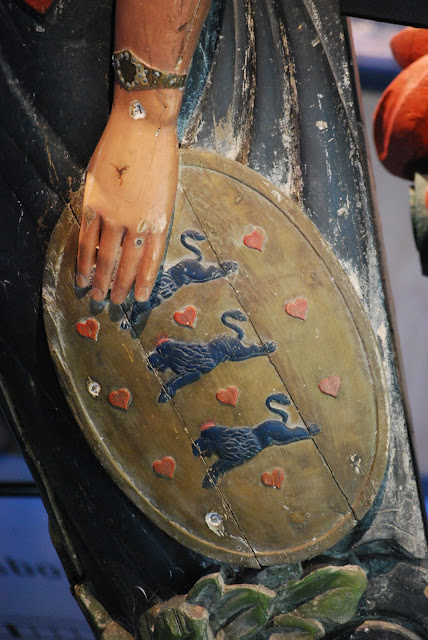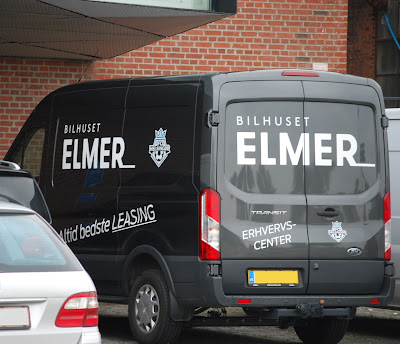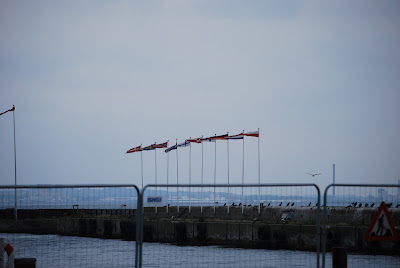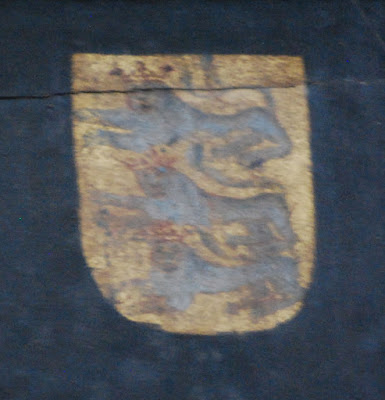Reviewing my last several photographs from Roskilde Cathedral in Denmark, I got to looking at one memorial board, and it reminded me of an article a number of years ago about a Town Crier in a city in England (it was most likely either Nottingham or York, but I do not recall which city for sure) who, in addition to advertising some of the many tourist shops and their wares available, made some remark about the many "American visitors, who come here to share in our history because they have so little of their own."
And in some ways that statement is correct, as the history of British North America only goes back to 1585 with the founding of the short-lived Roanoke colony in what is now North Carolina, but doesn't really begin until 1607 (the founding of Jamestown in what is now Virginia) and 1620 and 1635 (the founding of Plymouth and Boston, respectively, in what is now Massachusetts).
Compare that relatively short history with that of England, where I've been able to visit: St. Martin's Church, Canterbury, founded as a church about the year 580 (and still used for church services today!), and where you can still see some of the original Roman wall; or the Tower of London, originally built by William the Conqueror in 1066 shortly after his victory at the Battle of Hastings.
And thinking about all that reminds me of the old saw about "What is the difference between Europeans and Americans? Europeans think that 100 kilometers is a long way, and Americans think that 100 years is a long time." The truth of this was impressed upon me when we were on the tour following the 2016 International Congress of Genealogical and Heraldic Sciences held in Glasgow, Scotland, when we were on the bus for quite a while and eventually found ourselves near the outskirts of Edinburgh. Checking a map later, we discovered that Edinburgh was about 40 miles from Glasgow, or roughly the distance from downtown Dallas to downtown Fort Worth. Some of our European friends seemed to feel that 40 miles was a very long way; we Americans would drive that far to meet some friends for lunch. On the flip side, though, we were visiting places whose history sometimes ran back into the 1600s, 1500s, 1400s, and 1200s; a very long time ago! At least to us, living next to a large city founded in, let's see, 1841, "only" 180 years ago.
Anyway, to get back to the object that started this whole reminiscence, there is in the Cathedral an armorial Epitaph to Saxo Grammaticus, the late 12th Century author of the Gesta Danorum, the first full history of Denmark. (Books 3 and 4 of the Gesta give the history of prince, later king, Amleth, the historical figure who served as the inspiration for William Shakespeare's The Tragedy of Hamlet, Prince of Denmark.)
The memorial is all in Latin, so I find myself a bit like Casca in Shakepeare's Julius Caesar, where when reporting the effect of Cicero orating in Greek, and not understanding Greek himself, says, "those that understood him smiled at one another and shook their heads; but, for mine own part, it was Greek to me." Thus, this Latin inscription is "Greek to me."
I just found it interesting that there are two dates here; one says that Saxo died in 1190, (Wikipedia says that he lived c.1150-cs.1220.) The other date notes that this memorial was renovated in 1728. (You can click on the image above to go to a larger version, where you can see the details far more clearly than in the thumbnail above.)
Two dates; one roughly 300 years ago, and the other more than 800 years ago!
There are two shields painted on the top of this Epitaph.
The one on the left is, I am assuming, the arms of the Cathedral or Diocese of Roskilde. (I could, of course, be wrong about that assumption, but it looks likely, and the arms bear some similarities with the current arms of the Diocese of Copenhagen.)
The other (which did not come out as well-focused as I would wish) is the lesser arms of Denmark. (I do not see the hearts on the shield between and around the lions that you normally see on these arms.)
Anyway, there you have it! Heraldry; old stuff; even older stuff. All just a "short" train ride from Copenhagen, in Roskilde.





































